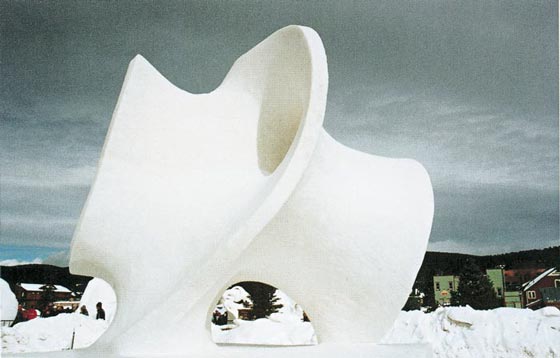
This Article From Issue
January-February 2002
Volume 90, Number 1
DOI: 10.1511/2002.13.0
In the gray light of a wintry day, the giant, sleekly curved figure reclining on its icy couch appeared ready for slumber. From some angles, the snow sculpture resembled a strangely contorted bell; from other angles, a piece of surreal plumbing or an ancient urn worn smooth by time. Its curious system of tunnels echoed the work of British sculptor Henry Moore.

From Fragments of Infinity.
The setting was the ski resort town of Breckenridge in the Rocky Mountains of Colorado. The occasion was the 1999 International Snow Sculpture Championships. In this annual event held in January, teams from around the world compete by carving sculptures out of twelve-foot-high, twenty-ton blocks of densely packed, machine-made snow. In 1999 one team, headed by Helaman Ferguson, dared to put forward a purely mathematical form as its entry in this prestigious competition.
The chosen shape was the central portion of the Costa surface, named for the Brazilian mathematician Celso J. Costa, who had discovered the equations for this particular figure in 1983. The Costa surface belongs to the family of geometric shapes known as minimal surfaces.
A minimal surface is one for which any distortion, no matter how small, increases its area. . . .
Intriguingly, Ferguson’s sculptures of the Costa surface . . . represent the culmination of an exploration that started more than two centuries ago with scientific observations of soap films in nature. In the years that followed, mathematicians developed equations to describe such surfaces. Costa probed those generic equations to uncover a novel minimal surface no one had seen before. Inspired by this form, Ferguson’s creations completed a cycle back to nature, making concrete what was initially just equation and computer-generated picture.
From Fragments of Infinity: A Kaleidoscope of Math and Art
Ivars Peterson
John Wiley and Sons, $29.95
American Scientist Comments and Discussion
To discuss our articles or comment on them, please share them and tag American Scientist on social media platforms. Here are links to our profiles on Twitter, Facebook, and LinkedIn.
If we re-share your post, we will moderate comments/discussion following our comments policy.